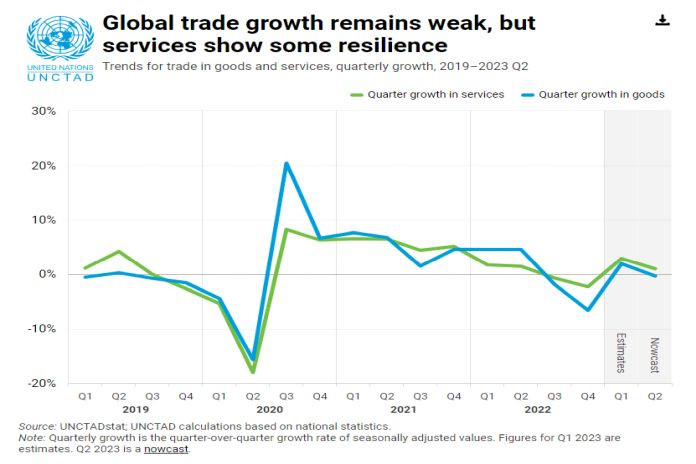GENEVA, Switzerland, (UNCTAD) – During the first quarter of 2023, trade growth was positive for both goods and services, according to UNCTAD’s latest Global Trade Update published on 21 June. After the downturn in the second half of 2022, world merchandise trade rebounded in both volume and value.
Over the first three months of 2023, trade in goods went up by 1.9 percent from the last quarter of 2022, adding about $100 billion. Global services trade also increased by about $50 billion, up by about 2.8 percent compared to the previous quarter.
For the second quarter of 2023, the UNCTAD nowcast suggests a slowdown in global trade growth, pointing to recently downgraded world economic forecasts and factors such as persistent inflation, financial vulnerabilities, the war in Ukraine and geopolitical tensions.
“Overall, the outlook for global trade in the second half of 2023 is pessimistic, as negative factors dominate the positive,” the report says.
‘Friend-shoring’ and increasing concentration of global trade
Over the last five quarters, the geographical proximity of international trade remained relatively stable, suggesting a lack of significant nearshoring or farshoring trends, at least on average.
The report points out that “friend-shoring” has been on the rise since late 2022, characterized by a reorientation of bilateral trade flows to prioritize countries that share similar political values.
The war in Ukraine, the decoupling of the United States-China trade interdependence, and the consequences of Brexit have played a significant role in shaping key bilateral trade trends during this period.
“Concurrently, there has been a decline in the diversification of trade partners, implying that global trade has become more concentrated among major trade relationships,” the report notes.
The report illustrates the ongoing decline in trade interdependence between the United States and China. It shows that over the past year and a half, the United States has become relatively less significant as an export market for China. During this period, the United States’ dependency on China as a supplier has decreased even further.
Varying trade performance among major economies
The report shows that merchandise trade growth has been mixed among the world’s major economies during the last four quarters.
Brazil, India, the United States and the European Union saw significant increases in both imports and exports.
But on a quarter-over-quarter basis, trade trends for major economies were more subdued between January and March 2023, and in many cases negative. The notable exception is significant growth in exports from China and India.
Regional trade trends
On a yearly basis, all regions saw international trade grow, except for the Russian Federation and Central Asian economies.
But the growth in the East Asian region has been significantly below average.
On a quarter-over-quarter basis, the first quarter of 2023 witnessed a decline in the value of trade in most regions, except for the Pacific region, North America and Africa, which experienced marginal growth.
Intra-regional trade during the same period followed similar patterns. But notably, trade within Africa increased by 3 percent, outperforming other intra-regional trade.
How various sectors fare
Global trade trends over the past four quarters were influenced by the energy sector, where rising prices resulted in higher trade values, until an 11% quarterly drop between January and March 2023.
Other sectors that experienced trade increases were agri-food products, apparel, chemicals and road vehicles.
Conversely, trade declined in office and communication equipment, as well as transport, where downward trends continued into the first quarter of 2023.





